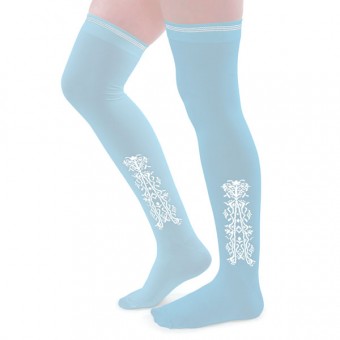The structural layers for my Louisbourg ensemble are finally done! This actually includes a sort of dark lavender-grey wool petticoat, but I don't have photos of that yet so I'll just post the photos with chemise, hoop, and stays. I also have light blue American Duchess clocked stockings to go with this, so all in all it will be a very blue and white set of underwear. =D
First of all, here is a triptych:

Here are some close-up photos of the stays. They are based on the 1740s pattern in Norah Waugh's Corsets and Crinolines, re-drafted for my body. They are entirely hand-stitched, inside and out, and the pieces were butted and whipped together. The outer fabric is a fine worsted wool from Burnley and Trowbridge, interlined in factory cotton and cotton coutil (ugh...it was for class, so we were required to use coutil. I would rather have gone with linen canvas, but ah well). They are lined in white linen, with the tabs lined separately. The bindings and seam covers are pigskin. Since these photos, I have re-laced them with linen tape, also from Burnley and Trowbridge. They are fully boned in flat steels which were individually cut for the channels (more than 180 bones, altogether). There are horizontal bones across the stomacher and around the ribcage as well as the vertical bones.



You can see the horizontal bones in this photo from before they were lined:

I've never bound tabs before. These took about 7 hours of solid work, if I remember correctly. I was running on two nights without sleep at that point, though. Half the tabs bound, and before the straps were on:

Here they are finally lined and ready to hand in:

And on to the hoop! The hoop is based off of one documented by Dr. Lynn Sorge English in a small museum in England (accession number 2008 353/1 from the Museum Resource and Learning Center, Hereford, UK). It's similar to one in Costume Close-Up, if anyone has that book, except that on this one the cartridge pleating extends up above the top hoop instead of disappearing into the seam. There are four hip panels, each of which has two quilted sections stuffed with lambswool. There are three rows of cane (the original hoop had iron rod, but we used halved wooden reed instead, and steamed it into shape with the tailoring irons). Each cane is held in a separate casing which is only tacked to the skirt itself at a few points along its length - with the exception of the top edge of the top cane, which is whipped to the bottom of the hip panels all the way along. Likewise, the bottom of the cartridge pleating is sewn to the bottom edge of the hip panels all the way around, but is only tacked at the top here and there. The middle hoop is held into an elliptical shape with two sets of ties on the inside. The top hoop is actually 15 cm longer than the circumference of the hip panels, and overlaps on the inside. Thus, since the hip panels themselves are on a drawstring at the waist, the top "wheel" of the skirt can be made larger or smaller based on preference.
It looks as if the padded panels of the skirt at jutting up above my waist here; they are held down by the weight of the petticoats that go over the hoop skirt, and eventually the lambswool will flatten.
Back:

There is a "V" steamed into the top cane at center front, which you can see here. It was hard to get it in there, as it goes against the grain and curve of the wood, but it very nicely forces the front of the hoop flat and the back of the top hood up and out, forming a lovely rump effect. =P

You can really see how the top hoop is angled up and back from center front. You can also see the opening for the pockets here:

And here's what it all looks like together!



And try to picture it with these stockings from American Duchess and some lovely period shoes that I have yet to make, instead of my winter boots:

=)
Fantastic! Do you make and sell these costumes?
ReplyDelete